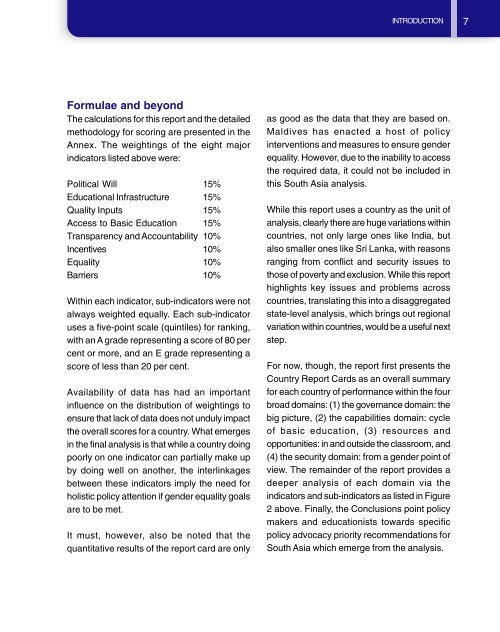Cover(final) - United Nations Girls' Education Initiative
Cover(final) - United Nations Girls' Education Initiative
Cover(final) - United Nations Girls' Education Initiative
You also want an ePaper? Increase the reach of your titles
YUMPU automatically turns print PDFs into web optimized ePapers that Google loves.
INTRODUCTION 7<br />
Formulae and beyond<br />
The calculations for this report and the detailed<br />
methodology for scoring are presented in the<br />
Annex. The weightings of the eight major<br />
indicators listed above were:<br />
Political Will 15%<br />
<strong>Education</strong>al Infrastructure 15%<br />
Quality Inputs 15%<br />
Access to Basic <strong>Education</strong> 15%<br />
Transparency and Accountability 10%<br />
Incentives 10%<br />
Equality 10%<br />
Barriers 10%<br />
Within each indicator, sub-indicators were not<br />
always weighted equally. Each sub-indicator<br />
uses a five-point scale (quintiles) for ranking,<br />
with an A grade representing a score of 80 per<br />
cent or more, and an E grade representing a<br />
score of less than 20 per cent.<br />
Availability of data has had an important<br />
influence on the distribution of weightings to<br />
ensure that lack of data does not unduly impact<br />
the overall scores for a country. What emerges<br />
in the <strong>final</strong> analysis is that while a country doing<br />
poorly on one indicator can partially make up<br />
by doing well on another, the interlinkages<br />
between these indicators imply the need for<br />
holistic policy attention if gender equality goals<br />
are to be met.<br />
It must, however, also be noted that the<br />
quantitative results of the report card are only<br />
as good as the data that they are based on.<br />
Maldives has enacted a host of policy<br />
interventions and measures to ensure gender<br />
equality. However, due to the inability to access<br />
the required data, it could not be included in<br />
this South Asia analysis.<br />
While this report uses a country as the unit of<br />
analysis, clearly there are huge variations within<br />
countries, not only large ones like India, but<br />
also smaller ones like Sri Lanka, with reasons<br />
ranging from conflict and security issues to<br />
those of poverty and exclusion. While this report<br />
highlights key issues and problems across<br />
countries, translating this into a disaggregated<br />
state-level analysis, which brings out regional<br />
variation within countries, would be a useful next<br />
step.<br />
For now, though, the report first presents the<br />
Country Report Cards as an overall summary<br />
for each country of performance within the four<br />
broad domains: (1) the governance domain: the<br />
big picture, (2) the capabilities domain: cycle<br />
of basic education, (3) resources and<br />
opportunities: in and outside the classroom, and<br />
(4) the security domain: from a gender point of<br />
view. The remainder of the report provides a<br />
deeper analysis of each domain via the<br />
indicators and sub-indicators as listed in Figure<br />
2 above. Finally, the Conclusions point policy<br />
makers and educationists towards specific<br />
policy advocacy priority recommendations for<br />
South Asia which emerge from the analysis.

















